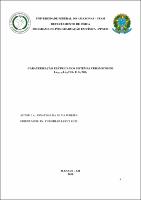| ???jsp.display-item.social.title??? |


|
Please use this identifier to cite or link to this item:
https://tede.ufam.edu.br/handle/tede/6632| ???metadata.dc.type???: | Dissertação |
| Title: | Caraterização Elétrica dos sistemas cerâmicos de La(2/3-X)Li3XTiO3 e Li2TiO3 |
| Other Titles: | Electrical Characterization of the ceramic systems of (2/3-X) Li3XTiO3 and Li2TiO3 |
| ???metadata.dc.creator???: | Pereira, Jonathas da Silva  |
| ???metadata.dc.contributor.advisor1???: | Ruiz, Yurimiler Leyet |
| ???metadata.dc.description.resumo???: | A técnica de espectroscopia de impedância complexa foi usada para realizar a caracterização elétrica de dois sistemas cerâmicos: Titanato de Lítio Lantânio - La(2/3-X)Li3XTiO3 (LLTO) e Titanato de Lítio – Li2TiO3 (LTO). O estudo é feito sobre duas amostras para cada sistema, LLTO (La0,59Li0,24TiO3 e La0,56Li0,33TiO3) e LTO (moído e não moído). Os pós de nanopartículas de LLTO foram obtidos por moagem de altas energias (MAE) e sinterizados via Spark Plasma Sintering (SPS). Por outro lado, o LTO foi submetido à moagem de altas energias para reduzir o tamanho das partículas e sinterizado pelo método de sinterização convencional. A resposta elétrica de ambos os sistemas (LLTO e LTO) foi estudada, com o diferencial de avaliar as propriedades elétricas em cada caso. Medidas de impedância complexa foram realizadas na faixa de frequência de 1 Hz a 10 MHz e num intervalo de temperatura desde a temperatura ambiente até 270 °C. Três modelos foram usados para o processamento dos dados experimentais, o modelo do circuito equivalente, a lei universal de Jonscher estendida e o método da derivada. Por meio dos três modelos, foi possível obter a condutividade de DC e estudar as contribuições para a condutividade total, do grão e da fronteira de grão do LLTO. Enquanto o LTO foi estudado na faixa de frequência de 1 Hz a 1 MHz, no intervalo de temperatura de 25 °C a 200 °C. O efeito da moagem sobre a condutividade iônica foi verificado no sistema LTO. A condutividade intrínseca do LLTO (x = 0,08) foi da ordem de 10-5 a 10-3 S/cm na faixa de temperatura estudada. Para o LTO a condutividade iônica intrínseca foi da ordem de 10-10 a 10-7 S/cm. Além disso, a equação de Arrhenius permitiu determinar a energia de ativação total (Ea) de cada contribuição tanto do LLTO, quanto do LTO. Para La0,59Li0,24TiO3, valores de Ea de 0,394, 0,393 e 0,208 eV foram obtidos para o volume total, fronteira de grão e grão, respectivamente. Indicando que para o sistema LLTO o mecanismo condutivo é determinado pela mobilidade de íons Li+. Para o LTO sem e com moagem foram obtidos energia de ativação da amostra total de aproximadamente de 0,69 e 0,687 eV, respectivamente. Estes valores estão associados a um mecanismo de condução por vacantes de oxigênio simplesmente ionizado. |
| Abstract: | The complex impedance spectroscopy technique was used to perform the electrical characterization of two ceramic systems: Lithium Titanate Lanthanum - La (2/3-X) Li3XTiO3 (LLTO) and Lithium Titanate - Li2TiO3 (LTO). The study is done on two samples for each system, LLTO (La0.59Li0.24TiO3 and La0.56Li0.33TiO3) and LTO (milled and unground). LLT nanoparticle powders were obtained by high energy milling (MAE) and sintered by Spark Plasma Sintering (SPS). On the other hand, the LTO was subjected to high energy grinding to reduce particle size and sintered by the conventional sintering method. The electrical response of both systems (LLTO and LTO) was studied, with the differential of evaluating the electrical properties in each case. Complex impedance measurements were performed in the frequency range of 1 Hz to 10 MHz and in a temperature range from room temperature to 270 ° C. Three models were used for experimental data processing, the equivalent circuit model, the extended Jonscher universal law and the derivative method. By means of the three models, it was possible to obtain the conductivity of DC and to study the contributions to the total conductivity, grain and grain boundary of the LLTO. While the LTO was studied in the frequency range of 1 Hz to 1 MHz, in the temperature range of 25 ° C to 200 ° C. The effect of grinding on ionic conductivity was verified in the LTO system. The intrinsic conductivity of LLTO (x = 0.08) was in the order of 10E-5 to 10E-3 S / cm in the temperature range studied. For the LTO the intrinsic ionic conductivity was of the order of 10E-10 to 10E-7 S/cm. In addition, the Arrhenius equation allowed to determine the total activation energy (Ea) of each contribution of both the LLTO and the LTO. For La0.59Li0.24TiO3, Ea values of 0.394, 0.393 and 0.208 eV were obtained for the total volume, grain and grain frontier, respectively. Indicating that for the LLTO system the conductive mechanism is determined by the mobility of Li + ions. For the LTO without and with milling, activation energy of the total sample of approximately 0.69 and 0.687 eV, respectively, was obtained. These values are associated with a mechanism of conduction by simply ionized oxygen vacancies. |
| Keywords: | Condutividade iônica Sinterização SPS |
| ???metadata.dc.subject.cnpq???: | CIENCIAS EXATAS E DA TERRA: FISICA |
| Language: | por |
| ???metadata.dc.publisher.country???: | Brasil |
| Publisher: | Universidade Federal do Amazonas |
| ???metadata.dc.publisher.initials???: | UFAM |
| ???metadata.dc.publisher.department???: | Instituto de Ciências Exatas |
| ???metadata.dc.publisher.program???: | Programa de Pós-graduação em Física |
| Citation: | PEREIRA, Jonathas da Silva. Caraterização Elétrica dos sistemas cerâmicos de La(2/3-X)Li3XTiO3 e Li2TiO3. 2018. 87 f. Dissertação (Mestrado em Física) - Universidade Federal do Amazonas, Manaus, 2018. |
| ???metadata.dc.rights???: | Acesso Aberto |
| ???metadata.dc.rights.uri???: | http://creativecommons.org/licenses/by-nd/4.0/ |
| URI: | https://tede.ufam.edu.br/handle/tede/6632 |
| Issue Date: | 5-Jul-2018 |
| Appears in Collections: | Mestrado em Física |
Files in This Item:
| File | Description | Size | Format | |
|---|---|---|---|---|
| Dissertação_Jonathas Pereira PPGF.pdf | 2.56 MB | Adobe PDF |  Download/Open Preview |
This item is licensed under a Creative Commons License





